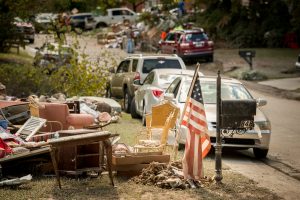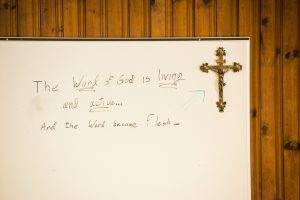
When LCMS Disaster Response “deploys” to an area that’s been affected by a disaster, the reasons/goals are generally similar from one disaster to another: to meet with local pastors, congregational leaders, and even district representatives to assess the situation, to provide guidance to the congregation and district as they develop some kind of an action plan for responding with Christ’s mercy to those who have been affected, and to bring the capacity needed to respond appropriately within the context of the particular disaster.
More often than not, this means that I will visit with church members who have lost their homes and have no place to live, or pastors who no longer have a pulpit (because it’s blown away or destroyed in some other way) from which to preach. As these visits are made, the mercy and love of Christ are brought again to those who are suffering, and those in the church who are in a position to show that mercy and love to others are strengthened in their resolve.
Many times, I’m able to joyfully work with local LCMS leaders in determining a unique way for the local LCMS congregation to not get lost in the response. And to be honest, it’s easy to get lost by either duplicating what other groups are doing, or by simply ‘joining forces’ with some other group active in disaster. However, the goal is to help the church “be the church” in that place, so that the suffering are pointed to LCMS altars, pulpits and fonts, where the forgiveness of sins and the comfort of the resurrection are preached into the hearts and minds of all those present.
This is generally very rewarding “work.” Yet at the same time, the whole process can be quite challenging. Long days with odd hours (sounds like the work of a pastor, right?) are typical. Strained relationships between brother pastors and district officials, and divergent ideas of what should be done (sounds like more than a few circuit meetings or council meetings, doesn’t it?) sometimes get in the way. And yet the Lord still works in the midst of this, perhaps even in spite of this, as the suffering are cared for by His church (and church-workers!) in body and in soul. The entire Body of Christ works and moves together (with squeaks, moans and groans) as one little part is lifted up in prayer by the rest and provided for in their time of need.
Nevertheless, for all this “work,” it sometimes seems as if I’m not really “doing” anything. Sure, there are gift cards and eventually grants that provide direct assistance to hurting families (roughly $3.5 million in a ‘normal’ year). But of all the disaster sites I’ve been too, I can count on one hand the number of times I’ve actually rolled up my sleeves and physically assisted in the response in any significant way. Yet almost universally, the pastors I’ve visited and the families we’ve prayed with are incredibly appreciative of what it is that we do – to (literally!) walk alongside of those affected and those responding; to pray with them and let them know that they are not alone in this. I remind them that God is good and His mercy endures forever. In spite of what they see and in the face of terrible loss, God is with them and will never forsake them. The devil will not snatch them out of His hand.

This past week was no exception. I had the privilege of traveling to South Carolina to meet with pastors and congregational leaders in the Myrtle Beach, and Charleston areas. It was my second visit (pictures in this blog are from the first visit) to a state still recovering from what everyone has called ‘historic’ (1,000 year) flooding. Some of these areas received over 2 feet of rain over the course of 48 hours! During our short time together, we met and prayed with members whose homes had flooded and we walked the streets to speak with families and workers trying to rebuild their homes.
As an interesting note, I was reminded repeatedly throughout the visit that the damage could have been so much worse. Even though thousands of families in the Columbia area are still suffering, most neighborhoods in the other areas were spared. The church’s response in and around Columbia will be considerably longer and more involved than Charleston or Myrtle Beach and one or more visits there may still be in order.
With that being said, we also started to lay the groundwork for preparing the churches in these areas to respond in the wake of the ‘next’ disaster. This flooding has acted as a wakeup call for these churches and their communities that something much larger (and just as likely) could cause an even greater amount a damage: namely a hurricane.
It seems daunting, but there really are steps that a church can take to be prepared for just such as an event. Not just to make it through a disaster, but to actually be in a position to show mercy and love during that time of great need. That, however, would be a topic for another post. May God be with you all!